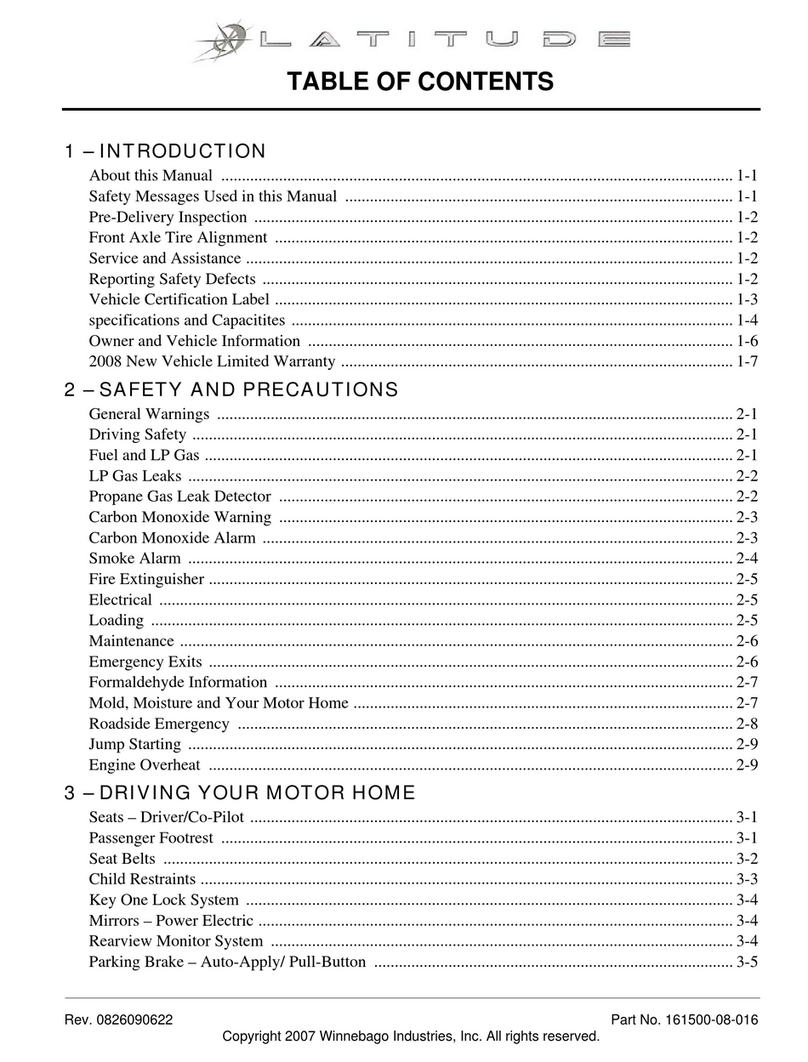
TABLE OF CONTENTS
LP Tank System.................................... 5-2
Refilling Tank ....................................... 5-2
Air in the LP Gas Tank ......................... 5-3
Traveling with LP Gas.......................... 5-3
Regulator...............................................5-3
LP Gas Leaks........................................ 5-4
Winter Use of LP Gas........................... 5-5
SECTION 6: ELECTRICAL SYSTEMS
110-Volt AC System .............................6-1
External Power Cord (Shoreline).......... 6-1
Power Center......................................... 6-2
Converter Charging Section.................. 6-3
Thermal Breaker ...................................6-3
110-Volt Circuit Breakers ..................... 6-3
110-Volt Receptacles (Outlets) .............6-4
Ground Fault Circuit Interrupter
(GFCI)................................................6-4
Auxiliary 110-Volt Generator
Operating Instructions................6-4 - 6-6
12-Volt DC System...............................6-6
Automotive (Starting) Battery ..............6-7
House Batteries..................................... 6-7
12-Volt Fuses ........................................ 6-7
Battery Access (Storage)....................... 6-8
Battery Maintenance............................. 6-8
Trailer Wiring Connector......................6-9
SECTION 7: PLUMBING SYSTEMS
Fresh Water System .............................. 7-1
Filling Water Tank ................................7-1
Fresh Water Tank Capacity...................7-1
Water Pump........................................... 7-1
Water Pump Switch............................... 7-1
Disinfecting Water Tank .......................7-2
External (City Water) Connector .......... 7-2
Shower Valve Pressure Bleed-Off ........7-3
Waste Water System.............................. 7-3
Dumping Holding Tanks.......................7-3
Using On-Site Sewer Hook-Ups...........7-4
Water Drain Valves ...............................7-4
Water System Winterization Valve ....... 7-4
Holding Tank Capacities....................... 7-6
Water System Drain Valve
Locations..................................7-7 to 7-9
SECTION 8: APPLIANCES AND
INTERIOR FEATURES
Refrigerator...................................8-1 - 8-4
Range and Oven.................................... 8-4
Microwave Oven................................... 8-5
Range Hood .......................................... 8-5
Monitor Panel ....................................... 8-5
Tank Leveling, Checking...................... 8-6
Water Heater ......................................... 8-6
By-Pass Valve ....................................... 8-7
LP Gas Furnace..................................... 8-8
Ducted Roof Air Conditioning .............8-8
Air Conditioner Selector Switch........... 8-8
TV Antenna......................................... 8-10
TV Signal Amplifier........................... 8-11
Cable TV Hook-Up ............................ 8-11
Video Control Center ......................... 8-11
Digital Satellite System Wiring .......... 8-12
DC-AC Electric Voltage Inverter........ 8-12
Exterior Entertainment Center ...........8-12
Sleeping Facilities
Overhead Bunk ................................ 8-12
Couch-Bed Conversion.................... 8-13
Dinette/Bed Conversion................... 8-13
Fresh Water Toilet............................... 8-13
Power Roof Vent ................................ 8-14
Slider Windows................................... 8-14
Day/Night Pleated Window Shades.... 8-14
SECTION 9: CARE AND MAINTENANCE
Roof ...................................................... 9-1
Underbody ............................................ 9-1
Exterior ................................................. 9-1
Waxing and Polishing........................ 9-1
Stripes and Decals, care of.................... 9-2
Interior Maintenance
Upholstery, Carpeting and
Draperies........................................ 9-2
Cabinets ............................................. 9-3
Vinyl Wallboard................................. 9-3
Tables and Countetops....................... 9-3
Stainless Steel Sink............................ 9-3
Bathroom ........................................... 9-3
Doors and Windows........................... 9-4
Window Roll-Up Shade Adjustment 9-4
Vehicle Maintenance
Chassis Service and Maintenance...... 9-4
Engine Access.................................... 9-4






























